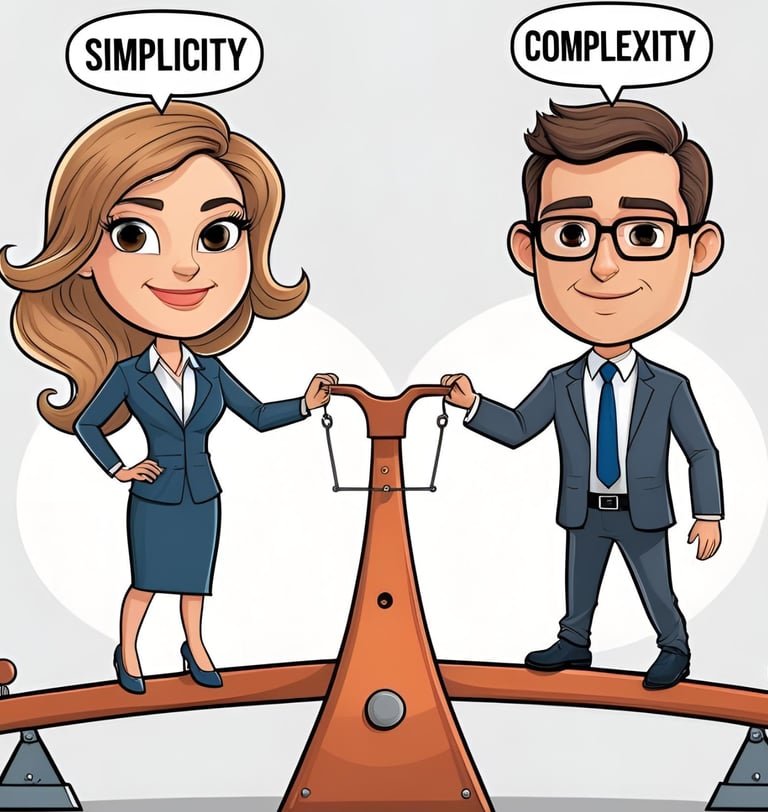Crafting a Strategy That's Simple to Read, Sophisticated to Run
When it comes to SaaS pricing, this is the perennial dilemma: do you offer a simple, frictionless pricing model that's easy to sell, or a complex, sophisticated one that captures every ounce of value? The answer, as I've found in my years of dissecting business strategies, is that the most successful companies manage to do both. They create a pricing "menu" that is simple on the surface, but sophisticated underneath.


In the world of restaurants, there are two types of menus. There’s the diner menu—simple, straightforward, and easy to understand, but with limited options and little flexibility. Then there’s the high-end tasting menu—complex, multi-course, and highly customizable, designed for a specific experience but potentially overwhelming to a first-timer.
When it comes to SaaS pricing, this is the perennial dilemma: do you offer a simple, frictionless pricing model that's easy to sell, or a complex, sophisticated one that captures every ounce of value? The answer, as I've found in my years of dissecting business strategies, is that the most successful companies manage to do both. They create a pricing "menu" that is simple on the surface, but sophisticated underneath.
At Foundational Edge, we don't believe you have to choose between simplicity and complexity. We believe you must embrace both in a way that serves your customers' needs while maximizing your business's potential.
The Case for a Simple "Menu" (On the Surface)
A simple pricing page is your front door. It’s what first-time visitors see, and it's where you have a few seconds to make a lasting impression. A complicated menu at the front door can lead to "analysis paralysis," where a customer sees too many options, gets overwhelmed, and simply leaves.
Clarity Drives Conversions: Presenting 3-4 clear, well-defined tiers (often following the "Good, Better, Best" model) reduces friction and helps customers make a quick, confident decision.
Marketing is Easier: Your marketing and sales teams can rally around a few core offerings, creating a consistent message that resonates with your target audience.
Predictability is a Superpower: For an early-stage business, the predictable revenue that comes from simple, fixed tiers is a crucial tool for financial planning and securing investment.
The goal of your front-end pricing page is not to offer every possible option, but to guide the vast majority of your customers toward the plan that's right for them with minimal friction.
The Necessity of a Sophisticated "Kitchen" (Underneath)
While your front door should be simple, your back-end operational structure should be as sophisticated as a gourmet kitchen. This is where you handle the nuances of value capture, enterprise needs, and the unique requests of your most valuable customers.
Capturing Enterprise Value: A simple three-tier page is great for SMBs, but it's not going to land a high-value enterprise client. These customers have unique needs for security, integrations, and custom features. A sophisticated back-end allows you to create custom quotes, negotiate bespoke contracts, and deliver a value-based solution that justifies a premium price. The "Enterprise" tier on your website might simply say "Contact Us," but your sales team knows they're about to open the door to your sophisticated kitchen.
Managing Usage and Expansion: Your public pricing might be based on a simple per-user model, but your internal system should be able to track and bill for a more nuanced value metric like API calls, data storage, or number of projects. This allows you to scale your revenue with customer usage without cluttering your public pricing page with every possible variable.
Optimizing the Upsell: A sophisticated back-end allows you to build a powerful engine for expansion revenue. You can use your data to identify customers who are about to hit their usage limits or who would benefit from a premium feature, and then trigger an automated, in-app upsell message that is relevant and timely. This is far more effective than a generic pop-up
.
Achieving the Perfect Balance: Simple on the Surface, Sophisticated Underneath
So, how do you build this ideal pricing "menu"?
Define Your Tiers for Your Core Audience: Start with 3-4 tiers that are perfect for the majority of your target customers. Give them clear names that reflect the value, and use a primary value metric that's easy to understand.
Have a Separate Plan for Everything Else: Don't try to cram every possible feature or scenario into your public tiers. Create a separate, "Contact Us for a Custom Plan" tier for enterprise clients or customers with complex needs. This keeps your main pricing page clean while still giving you the flexibility to handle bespoke deals.
Build a Robust Back-End: Your billing and analytics infrastructure needs to be able to handle complexity. G2 Learning Hub wrote, it should be able to track usage, monitor customer behavior, and integrate with your CRM to give your sales team a complete picture of each customer's value.
Treat Pricing as a Continuous Experiment: Your pricing menu should evolve with your product and your market. Continuously test new price points, new features, and new messaging to ensure that your pricing continues to be a growth engine, not a source of friction.
At Foundational Edge, we understand that navigating the simplicity-complexity continuum is a nuanced journey. It's about making informed, data-driven decisions that align with your product's value, your market's needs, and your organizational capabilities. Our white paper, "White Paper: SaaS Pricing Methods & Analysis" provides the comprehensive insights to help you strike that perfect balance, ensuring your pricing strategy is a catalyst for growth, not a source of friction.
